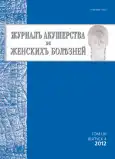The importance of automized antenatal cardiotocography for assessment of the functional state of fetuses with retarded development
- Authors: Kurmangali Z.K.1, Bapaeyva G.B.1, Ukibassova T.M.1, Aimagambetova G.N.1
-
Affiliations:
- National research center for mother and child
- Issue: Vol 61, No 4 (2012)
- Pages: 55-60
- Section: Articles
- URL: https://journals.rcsi.science/jowd/article/view/1339
- DOI: https://doi.org/10.17816/JOWD61455-60
- ID: 1339
Cite item
Full Text
Abstract
Full Text
##article.viewOnOriginalSite##About the authors
Zhanar Kuanishbaykizi Kurmangali
National research center for mother and child
Email: gauri.bapayeva@gmail.com
main scientific collaborator of radiologic, ultrasound and functional diagnostics of paraclinical department, MD
Gauri Billahanovna Bapaeyva
National research center for mother and child
Email: gauri.bapayeva@gmail.com
main scientific collaborator of obstetrics and gynecology department, MD
Talshyn Muhadesovna Ukibassova
National research center for mother and child
Email: gauri.bapayeva@gmail.com
head of obstetrics and gynecology department, MD, professor
Gulzhanat Nuratdinovna Aimagambetova
National research center for mother and child
Email: gauri.bapayeva@gmail.com
ob-gyn physician
References
- Алиева А. А. Медико-социальные аспекты инвалидности и медицинской реабилитации детей с последствиями перинатальной ишемии мозга и задержкой внутриутробного развития: дис… канд. мед. наук. — М., 2008. — 127 с.
- Герасимов А. Н. Медицинская статистика. — М.: МИА, 2007. — 367 с.
- Кардиотокография и допплерометрия в современном акушерстве / Орлов В. И. [и др.]. — Ростов н/Д., 2007. — 288 с.
- Крымшокалова З. С. Оптимизация диагностики и патогенетической терапии задержки роста плода: автореф. дис… д-ра. мед. наук. — Ростов н/Д., 2009. — 40 с.
- Кузин В. Ф. Современные технологии КТГ-мониторинга во время беременности и в родах // Медицинский алфавит. Больница. — 2009. — № 3. — С. 24–25.
- Медведев М. В., Юдина Е. В. Задержка внутриутробного развития плода. — М., 1998. — 205 с.
- Павлова Н. Г., Константинова Н. Н. Неврология плода — возможности и перспективы исследования // Журнал окушерства и женских болезней — 2003. — № 2. — С. 86–94.
- ACOG Practice Bulletin No. 100: Critical care in pregnancy. American College of Obstetricians and Gynecologists // J. Obstet. Gynecol. — 2009. — Vol. 113, N 2, Pt.1. — P. 443–450.
- Computerized analysis of normal fetal heart rate pattern throughout gestation/ Serra V. [et al.] // J. Ultrasound in obstetrics and gynecology. — 2009. — Vol. 34, N 1. — P. 74–79.
- Computerized FHR traces in post-term pregnancies / Piazze J. J. [et al.] // J. Perinat. Med. — 2008. — Vol. 36, N 2. — P. 182–183.
- Hui L., Challis D. Diagnosis and management of fetal growth restriction: the role of fetal therapy // J. Best Pract. Res. Clin. Obstet. Gynaecol. — 2008. — Vol. 22, N 1. — P. 139–58.
- The effect of maternal methadone use on the fetal heart pattern: a computerised CTG analysis/Navaneethakrishnan R. [et al.]//BJOG. — 2006. — Vol. 113, N 8. — P. 948–50.
Supplementary files







